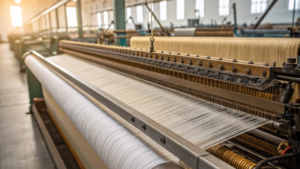How to solve common weaving spare parts failures of looms?

High-efficiency weaving loom producing fine quality fabrics in a bright industrial setting.[/caption]cing issues with loom spare parts can disrupt production and cost valuable time. This guide will help you identify and resolve common weaving failures effectively.
Loom failures occur due to improper maintenance, wear-and-tear, or incorrect settings. Identifying issues early and addressing them promptly ensures smooth weaving operations.
I’ve been managing textile machinery for years, and these solutions have saved my clients and me countless headaches. Let’s dive into each aspect of fixing and preventing loom failures.
How do you fix weaving mistakes?
Opening paragraph for h2: Mistakes during weaving can be frustrating but are often easy to fix if caught early. Here's how you can resolve them efficiently.
Common weaving mistakes include skipped threads, uneven tension, or thread breaks. Correcting these involves adjusting tension, repairing threads, and recalibrating your loom.

Dive deeper: Recognizing and correcting common weaving mistakes
Skipped threads:
Skipped threads often happen due to improper heddle threading or a loose warp. To fix:
- Identify the skipped thread.
- Rethread it through the correct heddle and reed.
- Adjust tension to prevent further skips.
Uneven tension:
Warp tension imbalances lead to uneven fabric. To address:
- Inspect the warp beam and check for inconsistencies.
- Use tension tools to ensure equal force across the warp threads.
- Regularly monitor during weaving.
| Problem | Cause | Solution |
|---|---|---|
| Skipped threads | Misaligned heddles | Re-thread and tighten tension |
| Uneven tension | Inconsistent warp distribution | Adjust warp beam evenly |
By following these steps, you’ll improve weaving accuracy and reduce errors.
How do you maintain and care for a loom?
Opening paragraph for h2: Regular loom maintenance prevents most spare part failures and keeps your machinery running smoothly. Let’s explore essential care techniques.
Loom care includes cleaning, lubrication, and periodic part inspections. These practices extend the life of your loom and enhance its performance.

Dive deeper: Effective loom maintenance techniques
Daily maintenance:
- Cleaning debris: Dust and lint accumulate on weaving looms and can clog parts. Use a soft brush or compressed air to clean daily.
- Inspecting warp and weft guides: Check for misaligned guides or broken parts.
Weekly checks:
- Lubrication: Ensure that moving parts, like the heddle frames and beaters, are well-lubricated. Use manufacturer-recommended oil for this process.
- Tightening bolts and screws: Vibration from weaving can loosen critical fasteners. Tighten them to ensure stability.
Monthly reviews:
- Inspect key spare parts like the heddles, reeds, and rotation sensors. Replace worn parts to prevent sudden breakdowns.
- Check the tension control mechanisms and adjust them for accuracy.
By staying consistent with these steps, your loom will operate efficiently, minimizing the need for costly repairs.
What is the problem of weaving?
Opening paragraph for h2: Weaving problems often stem from issues with spare parts or incorrect machine settings. Identifying these early is the key to avoiding defects.
Frequent weaving issues include improper thread tension, mechanical wear on spare parts, and inaccurate settings. Troubleshooting these ensures consistent production.

Dive deeper: Understanding and solving weaving problems
Common issues and solutions:
- Warp thread breaks: Often caused by rough heddles or incorrect tension. Smooth out damaged parts and readjust the tension.
- Uneven fabric density: May result from inconsistent shuttle movement or faulty beaters. Inspect and replace damaged parts.
Advanced challenges:
- Defective rotation sensors: Inaccurate readings disrupt fabric structure. Replace sensors immediately if calibration fails.
- Mechanical wear: Spare parts like tension discs, brakes, and gears degrade over time. Monitor their condition and replace them proactively.
| Issue | Cause | Solution |
|---|---|---|
| Warp thread breaks | Rough heddles or high tension | Smooth heddles, adjust tension |
| Uneven fabric density | Faulty shuttle or beater | Inspect and repair moving parts |
| Sensor calibration errors | Worn-out rotation sensors | Replace with high-quality alternatives |
These solutions help address core weaving problems, ensuring production quality remains high.
How do you ensure the weave structure is compacted during the weaving process?
Opening paragraph for h2: Ensuring a tight weave structure is essential for creating durable and uniform fabrics. Proper techniques and tools can help achieve this.
Compact weave structures rely on consistent tension, precise beater movement, and high-quality spare parts. Attention to detail during setup and operation is key.

Dive deeper: Techniques for a compact weave structure
Adjusting warp tension:
Maintain consistent warp tension to avoid loose spots in the fabric. Use a tension meter to measure and adjust the tension accurately.
Monitoring beater force:
Ensure the beater strikes evenly across the fabric. Check for wear or misalignment in the reed and replace it when necessary.
Using high-quality spare parts:
Invest in durable spare parts like tension discs, heddles, and rotation sensors. Quality parts reduce the risk of structural inconsistencies.
Key steps for compact weaves:
- Test the loom settings before starting a new project.
- Regularly inspect the fabric for any looseness or unevenness.
- Replace spare parts with precision-engineered alternatives from trusted suppliers.
By focusing on these details, your weave structure will be strong and uniform, suitable for high-demand applications.
Conclusion
Resolving loom spare part failures and ensuring smooth operations require regular maintenance, timely repairs, and high-quality components. Follow these practices to keep your weaving operations running efficiently.

2 Responses
Hi, this is a comment.
To get started with moderating, editing, and deleting comments, please visit the Comments screen in the dashboard.
Commenter avatars come from Gravatar.
2pLLJS40ACVyWJkCHkkrMRxFLTf